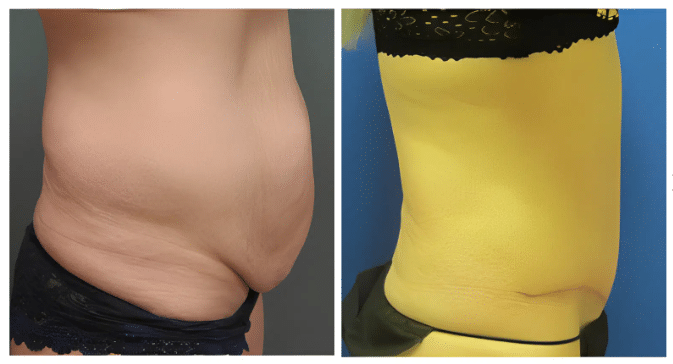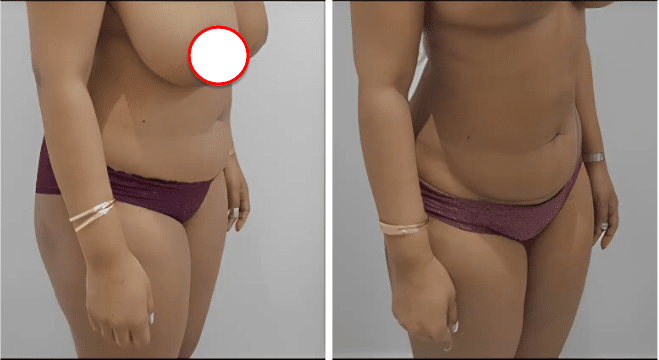
Liposuction in Orlando, Florida
Liposuction is one of the most popular body contouring procedures for men and women. This procedure gets rid of stubborn fat that does not respond to exercise or diet. It can also redefine your body shape and help you feel more confident. Patients undergo a single liposuction procedure or receive this surgery as part of a staged body contouring procedure.
All patients who undergo liposuction must be motivated to maintain their results through lifestyle modifications. With the right lifestyle changes, results from liposuction are typically permanent as the fat cells do not return. Many of these liposuction procedures are performed on an outpatient basis at our offices.
Our renowned board-certified surgeon Dr. Kenrick Spence offers liposuction surgery in Orlando, Florida. He tailors his surgery plans to help you reach your aesthetic goals. A liposuction procedure creates a smoother and slimmer body shape. Your clothes may fit better, and many patients say they feel more comfortable in their own skin. Have a look at how our surgeons transform bodies through liposuction. We also offer revision liposuction.
At Hillcrest Plastic Surgery, liposuction procedures range from $7,000 to $12,000. Contact us to learn more about financing options.
Fat Removal Expectations
Liposuction is not a weight-loss procedure. It is a body-contouring procedure that removes fatty tissue in areas such as the lower abdomen. After the procedure, when the desired amount of fat is removed, maintaining a healthy lifestyle can make results permanent.
The fat removed in a liposuction procedure generally amounts to four to five pounds. We are careful not to exceed the limits, as removing too much fat in a single procedure can be dangerous. Directly after your procedure, you will weigh more. This weight increase is due to slight swelling and the tumescent solution used during the procedure.
What Clients Say About Our Services
…Dear Dr. Spence and Team at Hillcrest, I just wanted to say “Thank you” for everything. I look better, feel better and it is all due to you and your wonderful team. Thank you again!
…..I cannot thank you enough for my recent surgery. I would describe the outcome as absolutely perfect and emotional impact is more than I could have hoped for. The confidence I feel as a result of my procedure has allowed me to become the person I always knew I could be. I am enjoying my life so much more and making the most of everyday. I was so impressed with your staff throughout the entire process. Ever member of the team that I interacted with from the initial call to my follow up visits, was knowledgeable, courteous and extremely professional. Since my procedure I have been doing very well. I have joined a gym and started exercising regularly and I eat healthier too. I’ve started to live a healthier, happier life. It is ironic how something artificial can suddenly make you feel so real. I could not be happier! Thanks for everything!!!!!
Dear Dr. Spence, You are truly a miracle worker. Thank you for your genuine caring and gifted hands.
Everyone from the front reception to the doctor were always courteous, patient, and available. I would definitely recommend this practice to my family and friends. - TP
See Our Phenomenal Results
Frequently Asked Questions
When you come in for your consultation with Dr. Spence, he will ascertain the elasticity in your skin. Skin elasticity is important because after the desired amount of fat is removed, the skin needs to be able to tighten down over its new, slimmer contours. If you still have good elasticity, loose skin will not be a problem, and your skin will tighten down to your slimmer contour.
Many patients also want to tighten the skin in the abdominal area for a contoured look. If our doctors think you have excess, sagging skin that seems to have lost its elasticity, they may recommend a tummy tuck (often with some amount of liposuction) to remove excess skin instead of only liposuction. This is only applicable to the areas around the abdomen, upper thighs and flanks. Our skilled surgeons offer tummy tucks — even for women who have received c-sections.
Thanks to our skilled team, modern liposuction procedures are minimally invasive. This is in sharp contrast to the original procedure introduced in the U.S. during the 1980s. During those days, liposuction procedures involved aggressive movement of the large cannula under the skin to loosen unwanted fat cells before suctioning them away. This old procedure created a good deal of blood loss and subsequent bruising and tissue trauma. Patients had to be under general anesthesia.
Our doctors use tumescent liposuction, where a saline solution containing Lidocaine and epinephrine is injected into the target area first. This swells the area for easier access, and the Lidocaine provides local anesthetic. The epinephrine constricts the blood vessels for less blood loss and bruising. We may also use power-assisted liposuction, which further helps to break loose the targeted fat cells.
Most patients equate the pain to more of an aching feeling and less of a sharp or dull pain feeling. While pain medication is available, most patients don't require anything stronger than over-the-counter options.
During your consultation, our doctors will pay close attention to your overall body proportions, as well as taking your overall health into account. A diagram will be drawn to show the areas of fat that will be addressed and after that, a few photographs are taken. Our doctors will evaluate skin tone, elasticity, areas of cellulite, contours of underlying muscle and bone structure. After doing so, our doctors will be able to give you a realistic understanding of the results you can expect.
Dr. Spence offers two types of liposuction: power-assisted liposuction and the tumescent technique. Dr. Spence was the first surgeon to introduce MicroAir power-assisted liposuction to Orlando, Florida, and has gained extensive experience with it over the years. Power-assisted liposuction is a new technology for body sculpting.
The tip of the liposuction instrument vibrates rapidly, with special contours in the tip that enable efficient removal of fat from previously hard-to-reach areas, such as the flanks of men. This allows the surgeon to have more precise control for the efficient removal of fat. This, therefore, decreases the amount of time you will be under general anesthesia.
Large volumes of fluid, called tumescent solution, are infused beneath the skin. This swells the area up and causes the small blood vessels to clamp down, which enables the efficient removal of fat with minimal amounts of blood loss. This produces much less trauma to the patient, speeds up their recovery and lessens bruising. Since power-assisted liposuction uses no heat to break up the fat pockets, there is much less risk of damage to the skin, as seen with some other forms of liposuction.
Our doctors use fine cannulas, lessening the risk of skin irregularities with less trauma to the tissue while shortening the recovery time. Due to the use of fine instruments and the placement of tiny holes for liposuction in areas hidden by the undergarments, the tiny holes are not closed and are allowed to drain immediately after surgery to help diminish swelling. Specially filled compression garments are applied right after surgery to help decrease swelling and support the elasticity of the skin.
Patients who want to undergo liposuction should stop smoking at least two weeks before the operation and until two weeks after the surgery. Smoking can cause surgical implications and reduce skin elasticity. Patients should also stop taking supplements and medications like aspirin, which can stop blood from clotting. Abstaining from these medications can help limit bruising, too.
Those who are getting larger areas treated should prepare a tranquil space in their home where they can rest and recover after surgery.
Some preparation tips include:
- Get hydrated before surgery (e.g., drink 8 to 10 glasses of water daily for 3 days prior to the procedure).
- Start a walking program prior to surgery (at least 20 minutes per day for 3 days)
Areas of Liposuction commonly addressed for women are:
- Neck
- Abdomen
- Arms
- Thighs
- Knees
- Back
The most common areas for men are:
- Abdomen
- Back
- Waist
- Neck
Which parts you can have liposuction treatment on also depends on the area or areas you had treated in the past. Larger areas of your upper thighs can also be a little more difficult to treat.
For most patients, liposuction is done on an outpatient basis, so you may return home that night. Patients undergoing large-volume liposuction, greater than 5 liters, are kept in a monitored setting overnight and are discharged home the following morning. The tumescent solution will drain from the tiny liposuction holes for approximately 24 hours.
Patients will be up and walking within a couple of hours of completing surgery. It is advised to be up and walking at least 3 times the night of surgery for 10 to 20 minutes each time. Walking helps to minimize any risk of clot formation in the legs. In the subsequent days, swelling goes down, and the skin overlying the areas of liposuction will remain numb. The underlying tissue will feel firm with knots. This is normal and will resolve over time. Massages are very important during this time.
Patients are referred to massage therapy as needed. Significant differences will be seen as early as 2 weeks after surgery, but your final results will not be seen for several months. Our doctors will instruct you as to when you can return to your specific exercise regimen.
Our practice provides a number of regimens to speed your recovery from liposuction, including:
- Oral agents such as Arnica Montana, Bromelain
- Topical agents for the skin to aid skin color in returning to normal if any bruising occurs during surgery.
- Bleaching creams to help fade the tiny holes from the liposuction scars
- Massage therapy to help speed your recovery
Your body has a limited amount of fat cells. They can decrease or increase in size as you lose or gain weight, but once you remove them, they are gone for good. It is possible for your body to build new fat cells, but only if you pick up a large amount of weight.
If you maintain a healthy weight and incorporate exercise into your lifestyle, you can enjoy a slimmer look for the rest of your life. Exercise and dieting can help keep fat growth to a minimum and help make liposuction results permanent.
It's not difficult to maintain your results because you'll have fewer fat cells in the treated areas. To maintain your slimmer contours, you simply need to maintain a healthy weight and make some form of exercise a part of your life.
Like any other surgery, liposuction has potential risks, including:
- Contour depression
- Clot formation in the legs
- Seroma - fluid collections beneath the skin
- Prolonged swelling
At the time of your consultation, our doctors will discuss additional risks that may be unique to your situation.
Schedule a Consultation Today!
If you are interested in learning more about Liposuction, or if you wish to determine whether you are a good candidate for the procedure, reach out to our office in Orlando, FL for a personalized consultation!
You can contact Hillcrest Plastic Surgery at 407-999-2585 to schedule your consultation. For any other inquiries, head over to our contact page and fill out our appointment request form. Dr. Kenrick Spence and our skilled team look forward to serving you!
American Society for Aesthetic Plastic Surgeons News Release

"Lipoplasty: Position Statement and Guidelines" - Nearly two decades of clinical experience have demonstrated that lipoplasty (liposuction) is safe and produces effective therapeutic outcomes. Lipoplasty is generally recommended for patients of normal weight who have localized fat deposits that are resistant..... read more.





